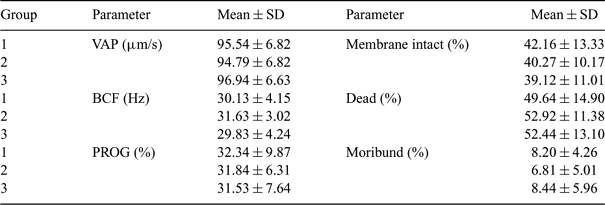113 EFFECT OF SPERM COATING ON THE QUALITY OF BOVINE FROZEN-THAWED SPERMATOZOA
M. Thys A , A. Van Soom A , J. Dewulf A , T. Rijsselaere A and A. de Kruif ADepartment of Reproduction, Obstetrics and Herd Health, Faculty of Veterinary Medicine, Ghent University, Merelbeke, Belgium
Reproduction, Fertility and Development 18(2) 164-165 https://doi.org/10.1071/RDv18n2Ab113
Published: 14 December 2005
Abstract
The substantial decrease of sperm quality after cryopreservation remains an important issue in the artificial insemination industry. Sperm coating with Triladyl® (Minitübe, Tiefenbach, Germany) during ejaculation can preserve sperm characteristics and oocyte penetrating capacity of fresh bovine spermatozoa stored in egg yolk diluent for up to 6 days (De Pauw et al. 2003 Theriogenology 59, 1109–1122). Since collecting semen in a tube containing egg yolk-Tris extender (sperm coating) limits the period of contact between spermatozoa and seminal plasma, the present experiment was conducted to assess if this slightly adjusted method of sperm collection could also have a significant effect on bovine sperm quality after cryopreservation. Semen of five young Holstein Friesian bulls was collected by means of an artificial vagina connected to an empty tube (Group 1; five ejaculates per bull) or a tube containing 4 mL of an egg yolk-Tris extender (Groups 2 and 3; each five ejaculates per bull). The semen samples of Group 1 were conventionally diluted in straws (60 × 106 sperm/mL), frozen, and stored in liquid nitrogen. The samples of Group 3 were centrifuged, and after removing diluent and seminal plasma, the sperm pellet was conventionally diluted and processed. The samples of Group 2 were processed without removal of the supernatant. After thawing each ejaculate was analyzed for average path velocity (VAP), beat cross frequency (BCF), and progressive motility (PROG) using CASA (Minitübe, Tiefenbach, Germany). Furthermore, the membrane integrity of each sample was evaluated using fluorescent SYBR®–14/PI staining (BD Biosciences, Erembodegem, Belgium). All parameters were compared among the three groups of sperm using univariate analysis of variance (SPSS 12.0; SPSS, Inc., Chicago, IL, USA). No significant differences could be observed among the three groups for all of the evaluated sperm characteristics (Table 1). A significant effect of the bull could be determined for all analyzed parameters (P ≤ 0.02), except for the percentage of moribund cells. Nevertheless, the group-bull interaction was never statistically significant. Coating bovine sperm with an egg yolk-Tris extender during ejaculation cannot prevent the substantial deterioration of the spermatozoa that occurs during freezing and thawing since this method of sperm collection does not significantly influence the motility parameters or the membrane integrity after thawing.

|
This research was supported by IWT (no. IWT/020727).


